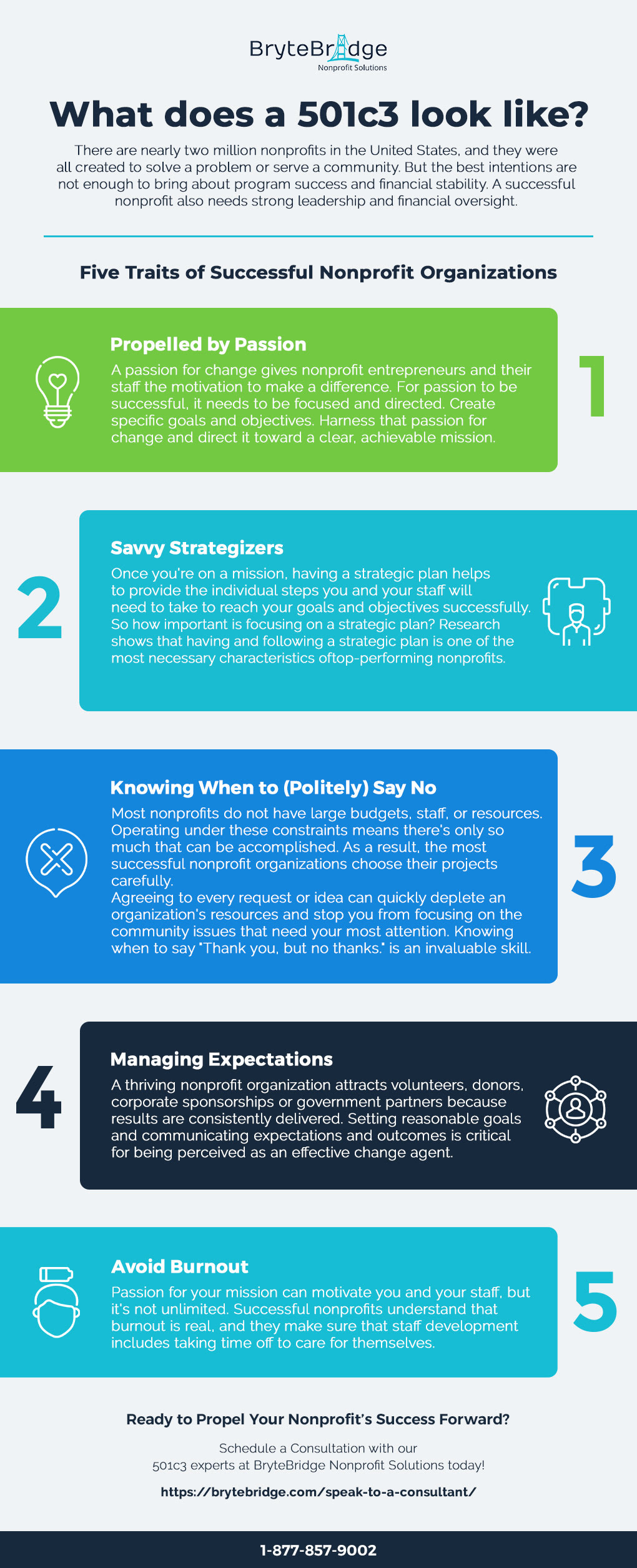Successful 501(c)(3) Nonprofit Organizations Are Created Every Day. Here’s How It’s Done.
No one ever said that building a successful 501(c)(3) nonprofit would be easy. Yet to become successful, nonprofit organizations need to create stability, remain relevant to their community, and exhibit resilience in the face of our ever-changing world.
So what does a successful 501(c)(3) look like? Successful charitable 501(c)(3)’s are financially stable, have cultivated a passionate and committed volunteer and donor base, and have strong leadership qualities. If you’re a nonprofit entrepreneur looking to launch a 501(c)(3), there are several positive characteristics you can incorporate into your strategic planning to help your nonprofit grow and thrive.
Five Characteristics of Successful Nonprofit Organizations:
1. They Are Agile

Agile methodologies have become popular in technology circles, but successful charities have always used these practices in their work. One great example of operating from an agile position is how many community food banks quickly responded to the COVID-19 pandemic. When it became unsafe to have families needing food to visit an inside foodbank, these nonprofits quickly retooled and found ways to distribute essential nutrition in safe, accessible ways.
What does an agile 501(c)(3) look like? Agile 501(c)(3)’s can quickly respond to change when a crisis or opportunity arises and increase their standing and value in their community.
2. They Are Focused On Their Mission, Always
Successful nonprofit organizations are constantly communicating their mission. This can be through a formal mission statement prominently displayed on a website and printed materials or the informal “elevator pitch” that an employee can use when asked to describe what the organization does.
What does a mission-driven 501(c)(3) look like? In successful nonprofit organizations, the mission, values, and purpose are more than words on a brochure or website– they’re embraced every day by an organization’s employees, volunteers, and donors. When the mission is part of organizational culture, everyone understands how they contribute to the organization’s long-term goals.
3. They Develop Diverse Funding Sources
A nonprofit is not so different from a business enterprise! Both need a steady stream of revenue to exist. Successful nonprofits tap into numerous funding sources: fundraising individual donations, applying for government and foundation grants, corporate sponsorships, in-kind donations, selling membership plans, goods, services, and more. Typically, it’s best practice for a nonprofit to limit a single income source category to no more than 30 percent of their total revenue stream. This kind of balanced income source portfolio is helpful because if a single source of income became unavailable, the nonprofit could quickly restructure and continue to survive.
Regardless of where the funds come from, successful nonprofit organizations excel with donor communications. Whether it’s individuals, a foundation, or a corporation, keeping your supporters informed of your progress and accomplishments is exceptionally valuable.
4. They Inspire Others
Nonprofit organizations can mobilize people to take action to support their cause. This includes people working in government agencies, the business sector, other nonprofit agencies, and the public. Inspiring people to take action results from having consistent marketing and communications plans that tell the stories of your nonprofit and the people you serve.
What does an inspiring 501(c)(3) look like? Successful nonprofit organizations become inspiring when their work encompasses many people throughout their communities. Nonprofits of this nature can create large-scale social movements, influence laws, and policies, and create meaningful dialogue that has the power to change attitudes and behaviors.
5. They Continuously Improve
Always embrace continuous quality improvement (CQI). One of the first principles of CQI is taking time to listen to your organization’s stakeholders (board, staff, volunteers, beneficiaries) and routinely solicit feedback. But it doesn’t stop at listening; the real transformational work begins when positive and negative feedback is used to strengthen and improve the organization.
Nonprofit organizations that become adept at leveraging CQI to collect data can more effectively enhance their programs and services. Establishing a culture of feedback creates an open, positive organization where all stakeholders feel their voices are listened to and valued.
Find Success in Your 501(c)(3) Nonprofit with BryteBridge Nonprofit Solutions
Whether you’re a seasoned nonprofit administrator or boot-strapping your first nonprofit startup, BryteBridge can help with every aspect of launching, sustaining, and growing your organization. Our experienced consultants can advise you on everything from marketing and communications to websites and digital technologies, payroll and tax accounting, human resources, and insurance. Over the years, we’ve helped thousands of 501(c)(3) organizations become successful nonprofits and enjoy long-lasting support and involvement in the communities they serve.
Still not convinced about BryteBridge.com? Check out our awesome reviews! We look forward to hearing from you!




